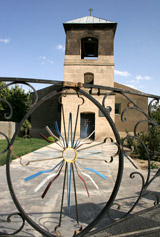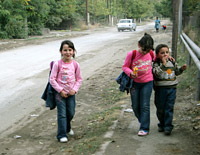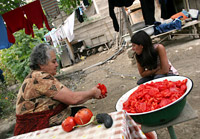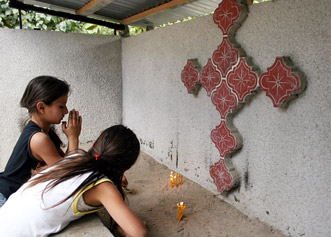

 Yerevan resident Susanna Kalashyan had just been promoted to the 8th grade when she was "stolen away" on the way to the school. Her "abductor" was an Assyrian from the village of Verin Dvin. More than forty years have since passed. Susanna has four children and eleven grandchildren. Her husband has long since passed away.
Yerevan resident Susanna Kalashyan had just been promoted to the 8th grade when she was "stolen away" on the way to the school. Her "abductor" was an Assyrian from the village of Verin Dvin. More than forty years have since passed. Susanna has four children and eleven grandchildren. Her husband has long since passed away.
While Susanna understands Assyrian quite well she doesn't speak the language. "I really wanted to learn my husband's native tongue but whenever I tried to speak it I'd get tongue-tied, she recounts. My speaking Assyrian just wasn't in the cards." Susanna's husband never forced her or the children to communicate in Assyrian. The three eldest children identify with their Assyrian roots just as matter-of-factly as they relate to their Armenian ones. As for the youngest son, Susanna says he's Assyrian to the very core. The boy devotes all his free time to the study of Assyrian culture and history.
The largest Assyrian community in Armenia lives in the village of Verin Dvin, located in the marze (province) of Ararat. 2,000 of the village's total population of 2,700 are Assyrian. Marriages such as Susanna's aren't rare in the village. Mixed Armenian-Assyrian marriages are fairly widespread. While strolling the streets of Verin Dvin you get the feeling that you're not in Armenia. That's because everyone speaks Assyrian. Both Assyrian and Armenian students are required to take a class that integrates the Assyrian language, literature and history up till the 11th grade. In all else, Assyrians differ little from Armenians. Both peoples share similar customs, family values and lifestyles. Assyrians are quite at ease when it comes to integrating into the Armenian mainstream.
In the view of Meline Tamarazova, the Mayor's Secretary, "This is quite natural. When is it that a nation strives to preserve its identity? When it's being persecuted in the diaspora. When relations are amicable, the assimilative process takes place quite on its own."
 Relations between Armenians and Assyrians, at times friendly, at times hostile, date back thousands of years. However Assyrians first appeared on the territory now comprising present-day Armenia essentially in the 19th and early 20th centuries. The first large wave came in 1828, with the signing of the Treaty of Turkmenchai that declared an end to the war between Russia and Persia. Large numbers of Assyrians relocated from Persia to Russia and some of them eventually to Armenia. The second large wave came from the Ottoman Empire during the period of the Armenian Genocide. Large numbers of Assyrians, estimates range from 275,000 to 700,000, also perished during these years. Assyrians fled to this side of the border along with Armenian refugees with the assistance of General Andranik.
Relations between Armenians and Assyrians, at times friendly, at times hostile, date back thousands of years. However Assyrians first appeared on the territory now comprising present-day Armenia essentially in the 19th and early 20th centuries. The first large wave came in 1828, with the signing of the Treaty of Turkmenchai that declared an end to the war between Russia and Persia. Large numbers of Assyrians relocated from Persia to Russia and some of them eventually to Armenia. The second large wave came from the Ottoman Empire during the period of the Armenian Genocide. Large numbers of Assyrians, estimates range from 275,000 to 700,000, also perished during these years. Assyrians fled to this side of the border along with Armenian refugees with the assistance of General Andranik.
Some 7,000 Assyrians lived in Armenia, mostly in the villages of Verin Dvin, Dimitrov and Arzni, up until independence was declared in 1991. Many have now left to work mostly in Russia and Ukraine where, "everything is much less expensive and the exchange rate of the U.S. dollar is higher." A large segment of the residents of Verin Dvin are now to be found in the Ukranian village of Kakhovka where they've established the settlement of "Little Verin Dvin".
 If you visit Verin Dvin during the daytime you'd think only children live in the village. The adults go to the fields to work in the morning and only return after dark. Once school is over for the day the children also go to the fields to lend a hand. The "fields" are basically kitchen-garden plots where the villagers grow the essential household table-fare, rarely selling the produce.
If you visit Verin Dvin during the daytime you'd think only children live in the village. The adults go to the fields to work in the morning and only return after dark. Once school is over for the day the children also go to the fields to lend a hand. The "fields" are basically kitchen-garden plots where the villagers grow the essential household table-fare, rarely selling the produce.
Susanna complains that classes at the village Russian school, named after the writer Pushkin, have been cut from 45 to 40 minutes so that the children can get to the fields in time to assist their parents with the crop harvest. Almost all of the 28 children in her 16 year-old granddaughter Susanna's classroom go to the garden plots to work, some missing school for days on end. Susanna never allows her grandchildren to miss a day of class.
There are two dance ensembles in Verin Dvin; the 'Niniveh' group for adults and 'Arbela' for the school pupils. If there's no upcoming performance to prepare for there is almost no dance practice during the autumn months due to the demands of the crop harvest. Sixteen year-old Sona Petrova, a dancer in 'Arbela', says that her group mostly performs at festivals devoted to Armenia's resident national minorities. Sona adds that if the dance ensembles didn't exist young people would have little to do apart from working in the gardens or in construction; that is if something was being built. This is why most young people seek to leave for the city.
 There are 37 residents of Verin Dvin now studying in Yerevan. Most return to the village every day after school lets out. Only those with relatives in the city remain.
There are 37 residents of Verin Dvin now studying in Yerevan. Most return to the village every day after school lets out. Only those with relatives in the city remain.
Village Mayor Lyudmila Petrova assures us that while Verin Dvin faces the same host of problems as any other village, the government, especially the Regional Governor's Office of the Ararat Marze, pays particular attention to the village. In the last two years Assyrian language primers have been printed in Armenia. Prior to this these texts were imported from Russia. Promises to pave the roads by next spring have also been made. The building of the village Cultural House, where the Mayor's Office, the Post Office, the first-aid station and the library are located, is currently being repaired. Preparations are underway to construct a separate building for the Post Office. Lyudmila Petrova hopes that one day the clinic will also be housed in separate premises. This is one of the major issues confronting the village. While the clinic is outfitted with good technical equipment and has one doctor and three nurses on staff, its present three- room space just isn't large enough. For example, due to a lack of space, the gynecological chair remains packed-up and unused.
There are two working Assyrian churches in Verin Dvin. Shara, the Holy Apostolic Catholic Assyrian Church of the East of Armenia is based on the Nestorian Church, while the Church of Marez follows the Orthodox faith. If Armenia was the first nation to adopt Christianity as the state religion, the Assyrians were the first people to accept the Christian faith as early as the 1st Century A.D. From the beginning, Assyrians professed the Nestorian doctrine that declares that Jesus exists as two separate persons; Jesus, the human being and Jesus, the Divine Son of God. Those Assyrians who migrated to Russia from Persia adopted the Orthodox faith. Those who fled to Armenia during the 1915 Genocide retained their traditional Nestorian religion for a time. Today, Assyrians living in Armenia are either followers of the Orthodox Church or profess Roman Catholicism. In accordance with Nestorian Church tradition only a cross is placed in the Church of Shara, while icons adorn the Church of Marez.
There is no Armenian church in Verin Dvin as there is no need of one. Armenians attend services at the Assyrian churches. Residents of the nearby Armenian village of Nerkin Dvin also participate in church services celebrating the Feast Days of the Assyrian churches (June 14th and July 3rd). Prelate Isahak Tamraz, a young clergyman who came from Iraq several years ago now conducts worship services. The religious holidays of both Armenians and Assyrians are almost the same, the only difference being the days on which certain ones are celebrated.
If you were to ask each and every Assyrian whether they dream of eventually having their own homeland, the response across the board would be positive. As to the question would they move to a newly created "Assyria", residents of Verin Dvin unconfidently answer, " That's really a tough question...after all Armenia is our homeland."
By Hasmik Hovhannisyan
www.hetq.am
Translated by Hrant Gadarigian

or register to post a comment.